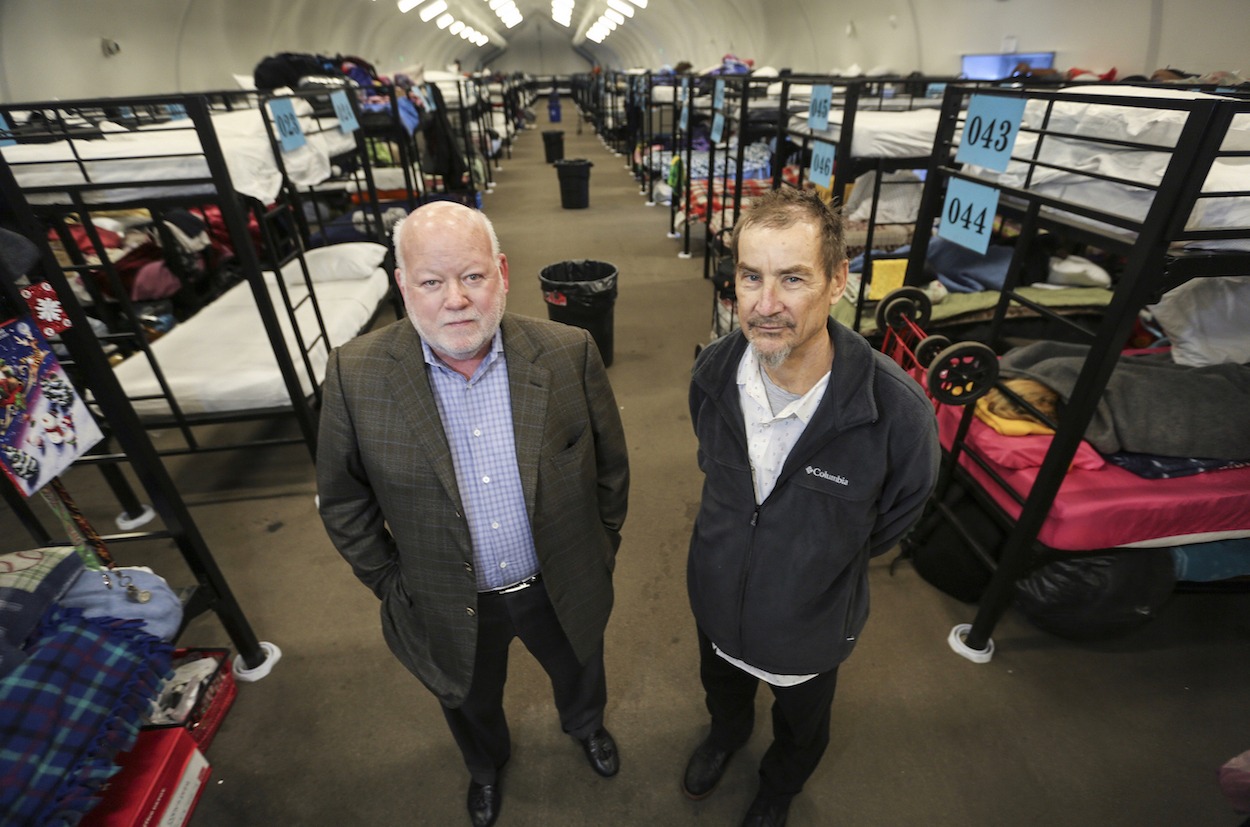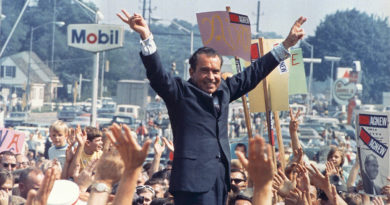Powerful Advocates for the Homeless
Dan Shea, left, and Peter Seidler in one of three temporary homeless shelters in San Diego. (Photo by Jamie Lyle Scott)
The Padres’ Peter Seidler and Donovan’s Dan Shea
Assemble a Working Group to Tackle one of the
City’s Most Pressing Social Problems
By the SD METRO Editorial Board
“The way to get started is to quit talking and begin doing,” said Walt Disney. It was this mantra that drove a small group of local business leaders to act in a humanitarian effort to help fellow San Diegans off the dangers of the street and into temporary housing.
After decades of problems the city of San Diego faced: Political upheaval; a pension crisis; the Great Recession that affected cities across the country; the woes of whether or not to put measures on the ballot that would increase the Tourist Occupancy Tax (TOT) to expand the convention center; and the threat – and then follow-through of the San Diego Chargers, who had called our city home since 1961, leaving San Diego. All political capital and public hand-wringing issues. While these civic issues were attention-grabbing problems that took a lion’s share of our city’s political leadership, one sad fact remained: No one seemed to give credence to the plight of our city’s homeless citizens. No one, except perhaps the nonprofit service providers who, with minimal budgets, have done what they can with very little resources.
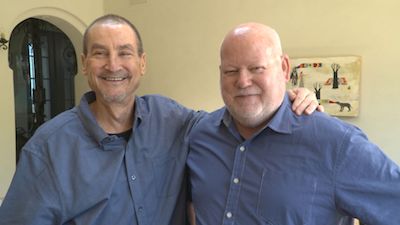
And then, out of nowhere — or not, San Diego became national news for the lack of care for its homeless population. In April 2017, it was widely reported that among the county’s homeless population, 62 percent were in the City of San Diego. The city’s total of 5,619 homeless represented a 10.3 percent increase from the prior year. In December 2017, an annual Homeless Assessment Report to Congress by the U.S. Department of Housing and Urban Development said San Diego County had the fourth-largest homeless population in the United States. The San Diego region’s total of 9,100 homeless people was behind only New York City, Los Angeles County, and King County, Wash., which includes Seattle. According to the report, San Diego ranked 10th nationally, with 1,589 homeless families with children; seventh in 1,160 unaccompanied homeless youth ages 18-24; and third for homeless veterans, approximately 1,067 military veterans in a city — which is designated as the second best military town in the country, contributing hundreds of millions of dollars to our local economy. It became evident that our community had failed to care for the men and women who have served our country.
In mid-2017, San Diego yet again made national news with the Hepatitis A outbreak that killed 20 people, and sickened hundreds of others — two-thirds of which were homeless, illicit drug-users, or both.
There’s a little-known back story about private citizens and businessmen and women taking a deep-dive to help San Diego’s homeless. It’s a story that deserves attention. Since coming to San Diego six years ago, Peter Seidler, majority owner and managing partner of the San Diego Padres, and CEO of Seidler Equity Partners, has said in numerous public venues that the homeless crisis in San Diego can no longer be ignored, and “enough is enough.” On daily walks throughout the East Village — sometimes during the darkest hours of the night, Seidler experienced first-hand the troublesome problem of homelessness in the city and decided that compassion for people living on the streets and cleaning up neighborhoods trumped any other problems San Diego faced. In an article published by the San Diego Union-Tribune on March 18, 2017, Seidler was quoted as saying: “When you talk about America’s Finest City, they all brag about how this is better than L.A., and all the Major League executives last year say this is the jewel of Major League cities.” Further stating: “Then you have this obvious humane, social, economic shortcoming. We’ve got to address this.”

However, it was well before spring of 2017 that Seidler had a plan. Two years ago, Seidler asked businessman Dan Shea, owner of Donovan’s restaurants, to join him to help solve the humanitarian plight of the homeless in San Diego. Seidler made it clear that this was a personal issue; that he wanted to show compassion to people, while cleaning up neighborhoods.
_______________________________
Readers interested in supporting this effort to help the homeless can learn more and
make a donation to the Lucky Duck Foundation at their website, www.luckyduckfoundation.org
_______________________________
When Seidler and Shea were asked about what their experience had been in gathering public opinion on the homeless issue, after meeting with dozens upon dozens of business leaders, non-profit charities, and local political operatives, it boiled down – they said, to generalized misconceptions regarding the homeless population. Specifically: that most homeless citizens suffer from chronic mental illness, which according to their fact-finding is untrue in that, while statistics vary, it is generally accepted that approximately 30% of homeless people are chronically mentally ill, certainly not a majority. Also, as supported by the statics above, San Diego’s civic groupthink does not give enough credence to causes of homelessness amongst veterans with PTSD; and not even among the statistics – senior citizens who lost their homes in the recession and are now living in their cars. And, most unfortunately, foster children who have aged out of the system at 18 years, with a minimal support system. According to Shea, the general theme of most conversations regarding this issue was that people believe that all the homeless “want to be on the street”, which is not supported by facts. They understand that there is a small amount of people who chose to live on the street, but it is certainly not the majority. The group’s position is that they aim to help only the people who want help and who do not want to be living on the street.

For the past 20-plus months, Peter Seidler and Dan Shea have assembled a group of seven like-minded business and civic leaders who meet each Tuesday in Seidler’s office to discuss finding solutions for San Diego’s homeless problem. Business leaders, such as: Pat and Stephanie Kilkenny, CEO of K2 Insurance Services; Tom Mulvaney of the local Mulvaney legal family and board member at University of San Diego; Jeff Martin, CFO/Sempra Energy; Mitch Mitchell, VP of state government affairs for SDG&E; Keith Jones, managing principal and partner, ACE Parking; Dan Herbert, attorney with Higgs Fletcher & Mack; and county Supervisor Ron Roberts.
In an interview with SD METRO, Shea said that he and Seidler initially met for a discussion as to how, exactly, the homeless problem could be tackled. He said that they asked themselves: “What would we do in our own businesses?” They agreed that the issue should be approached “from the inside-out.” Over the course of several months, Shea said the group “consumed everything they could get their hands on” regarding the city’s efforts to combat the problem and concluded that it was not just a matter of money — as they had been told again and again. Rather, there were two primary issues that came into play: 1) leadership and/or the lack thereof; and 2) the proper organization of resources. The group also studied local and national “Housing First” models, which they agreed was a good model. However, lacking city land and other resources, the “Housing First” model would leave homeless, and even low-income citizens, without shelter — most likely sentencing them to life on the street for at least another five to 10 years. Seidler and Shea’s group did in fact believe that “Housing First” is a good model, but it should not be the “only model” because it needed a component that would get people off the street sooner and begin the process of helping the homeless immediately.

Seidler and Shea met with Mayor Kevin Faulconer in 2016 to discuss potential solutions to San Diego’s homeless crisis as a behind-the-scenes initiative. They made it clear that they did not care who got the credit, so long as positive action was being taken to relieve the plight of the homeless. The group also stressed that this was not a political issue for them. It was not about Republicans or Democrats, or about political ambitions. It was very simply a group who self-assembled to neither help nor hurt anyone’s political agenda; rather, they were politically agnostic. It was also stated that if the city remained immobilized on the issue, they would pivot and make it a robust public dialogue. Although they still work closely with the mayor, they took the conversation public after one year of little progress to help the homeless.
Late in 2016, Seidler and Shea’s group met with Dr. James Harris III, president of the University of San Diego, to discuss developing a “Best in Class” model based upon successful homeless solutions in other U.S. cities, specifically: Houston, Phoenix, and Salt Lake City. The team concluded that no practical endeavor concerning the homeless will work without an integrated approach to the issue. Chief among the integrated approach included 1) Full utilization of the Coordinated Entry System (CES); 2) a needs assessment component; 3) triage resources; and 4) full utilization of the Homeless Management Information System (HMIS).
In June of 2017, in partnership with the University of San Diego, Seidler and Shea’s team held a press conference to announce plans for a new idea: a temporary homeless shelter idea where Sprung Structure industrial tents would house up to 250 San Diegans in each shelter by the end of 2017. During the press conference, the USD/Seidler/Shea team again acknowledged the merits of the “Housing First” model, which could take up to a decade to fully implement. Instead, they wanted to focus on the city’s lack of urgency to get people off the street, which with the shelter proposal could occur in a matter of months. The team also committed to provide funding for some of the tents to begin the process immediately, if city and county government did their respective parts in contributing to daily shelter services, assessments, and mental health wrap-around services.
When Shea and Seidler began working on this issue, they were told time and again that “no one cares about the homeless,” Shea said in his interview with SD METRO. However, when they reached out to potential contributors and nonprofit organizations, what they found — according to Shea, was that, while philanthropists and service providers were ready, willing and able to help, the common theme of the discussions was there was no “organized effort” in which to participate.
Another common theme among service providers and potential contributors was that they stood ready to help, provided that the city and county took definitive action to address the homeless problem.
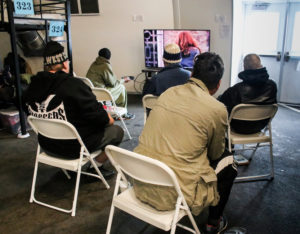
Testimony to that is that Feeding San Diego has stepped forward and guaranteed to cover all food needs in the shelters constructed by the group. Additionally, Family Healthcare Centers of San Diego announced they would provide medical, dental, and health care services to the shelter occupants, but only after government resources were utilized first. And then, recognizing the value that pets contribute to the lives of the homeless, Helen Woodward Animal Center stepped forward, citing research that shows that approximately 24 percent of the homeless population have pets, and that almost half of all their food goes to their pets. Equally disturbing is that many in the homeless population are unlikely to enter shelters because of their unwillingness to leave their pets — most likely the only family they have. Helen Woodward offered to provide on-site mobile veterinary services, including vaccines, spays and neutering, as well as food for the pets to not take nourishment from the homeless.
On Jan. 4, the last of three tent shelters opened in East Village, at 14th and Commercial streets. That shelter is operated by Father Joe’s Villages. The first shelter opened on Dec. 1, at 16th Street and Newton Avenue in Barrio Logan, which is operated by The Alpha Project, followed by a shelter located in the Midway District specifically designated to serve veterans and operated by Veterans Villages of San Diego. According to the mayor’s office, the three bridge shelters have brought the number of shelter beds in San Diego to 2,000.
While it is premature to predict the impact that these shelters will have on relieving the burden of San Diego’s first responders and emergency rooms throughout the city, it is a fair assumption that city resources will be more equitably balanced by the fact that 700 people now have timely access to medical services, thus reducing the burden on emergency services. A large portion of the homeless population will be given on-site resources by service providers. Problem solving all the way around.
It is well known that this small group of business leaders are reticent to see their names publicized; rather in numerous discussions they have made it clear that they prefer to quietly participate in the effort to help the homeless get off the street, on their feet and start anew. In fact, they only agreed to talk to us if it served one purpose: to continue raising awareness of the plight of the homeless and coming together as a community to find solutions. We call upon the city and county of San Diego to continue to participate in this public/private initiative to help San Diego’s homeless. Our fellow citizens’ lives are at stake. We see progress, but far more is needed.
Readers interested in supporting this effort to help the homeless can learn more and make a donation to the Lucky Duck Foundation at their website — www.luckyduckfoundation.org
__________________

Are Foreign Investors Driving Up Real Estate in Your Neighborhood ?
Moderate-income families getting squeezed out
By Matt Levin | CALmatters
Back in 2006, about 10 percent of California single-family homes were purchased in all-cash transactions, according to the real estate data firm ATTOM Data Solutions. A decade later, it’s nearly 25 percent. That means a quarter of California’s extremely tight housing inventory is unlikely to go to moderate-income families who need a mortgage to buy a home.
While all-cash buyers are often treated as a rough proxy for international buyers—the California Association of Realtors estimates they are more than twice as likely to pay in cash as domestic buyers—in reality they are more varied. Some are rich enough to not need to finance a first (or second or third) home, or simply prefer California real estate to the stock market. Private investment firms snapped up a ton of cheap homes during the foreclosure crisis—at one point more than one in three California homes was being purchased with all-cash. And increasingly older people, or their children, are liquidating assets to make all-cash offers.
But experts came to see foreign buyers as a bigger force in the market, and a contributor to the rise in single-family rentals California has seen the past 10 years.
“My guess would be that it’s flipped and that foreign buyers are now having a bigger impact than institutional investors,” said Daren Blomquist, senior vice president at ATTOM. “They aren’t a huge percentage of buyers, but certainly they are one of the reasons that the California market has bounced back so strongly from the recession.”
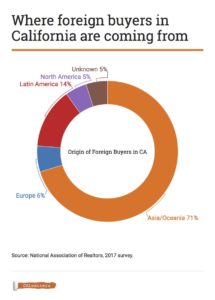
So what percentage of California’s housing stock is owned by foreign investors?
Let’s start with this major caveat: Foreign buyer real estate data is not good. California sales deeds don’t require a buyer or seller to disclose citizenship or residency status. So analysts rely on rough proxies for foreign ownership.
The house the Rothenbergs tried to buy is a good example. You can verify that the transaction was all cash, which is a good flag for a foreign buyer. You can verify that the tax address for the buyer is outside California, which is also a good flag. You can see the buyer’s surname, but given California’s demographic diversity, that’s hardly evidence foreign ownership.
But that’s all you can really say. Judging by the records, the owner of the Rothenbergs’ dream house could be a foreign-based investment buyer—or he might just be a wealthy Chinese-American who lives outside California and wants to invest in Sacramento real estate. (Attempts to contact the owners and the management company of the property were unsuccessful).
The California Association of Realtors estimates that 3 percent of last year’s purchases went to international buyers. Their data even suggests the share of international buyers has been on a downward trajectory since 2008—but that data relies on a survey of realtors, and could be undercounting.
“For one thing, the survey is conducted in English,” said Oscar Wei, senior economist for the California Association of Realtors. “So if you have Chinese buyers and Chinese agents, they may not necessarily want to participate in a survey written in English.”
Wei also acknowledges that Realtors may not always know the citizenship status of their clients, and that the timing of the survey could bias the overall results towards domestic buyers.
His rough estimate: 5 to 10 percent of the state’s single-family housing stock could be owned by international buyers.
Using data from the real estate data firm ATTOM Data Solutions, CALmatters created a heat map of all-cash home sales for each zip code in California—it’s available at CALmatters.org,
So can we conclude anything reliable about foreign buyers?
We do have a decent grasp on where they’re coming from.
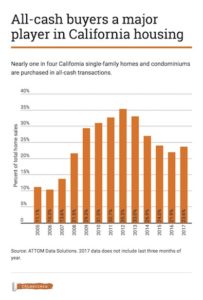
The fear of Chinese millionaires gobbling up American homes as just another piece in their global investment portfolio can veer into the cartoonish and xenophobic very quickly. As recently as 2014, Canadians purchased more U.S. homes than Chinese buyers, according to the National Realtors Association. And while Canadians are actually more likely to make all-cash offers, they receive nowhere near the scrutiny as the Chinese.
In California, however, Asian buyers do dominate: Last year they accounted for 71 percent of California homes sold to foreign buyers. That dwarfs the next closest group of international buyers, Latin Americans at 14 percent.
No state in the country has attracted nearly as much attention from Chinese buyers as California, site of nearly 40 percent of all Chinese home purchases in the U.S.
Why are the Chinese so enamored with California real estate? First, it’s important to understand what we mean by “foreign.” Those statistics include recently arrived immigrants, of which California has quite a few. There’s legitimate debate over whether those immigrants should be counted as “foreign.”
Many of the recently arrived Chinese snapping up California properties are holders of EB-5 visas—a U.S. program granting green cards to foreigners who invest $500,000 in U.S. business.
“The wife and kids are in the U.S., some of the husbands are here some of the time and some are not, they have a portion of their money here and they have a portion of their money in China,” says Lin He, a real estate investor and developer who courts Chinese property speculators in places like Newport Beach and Irvine.
The number of Chinese diaspora already settled in areas such as Orange County and the San Gabriel Valley attract a great deal of foreign investment because cultural and language similarities make the purchase process easier.
Much of that money goes towards primary residences—Chinese visa holders living with their family in a U.S. home. But after getting a foothold in California, many recently arrived Chinese view residential real estate as an attractive investment strategy—one that was not readily available to them in China, either because of government policy or exorbitant cost.
“The real estate in Beijing and some other places is really expensive,” says He. “They spend a year here, they buy a house, they say, “You won’t believe it, it’s so cheap here.”
The National Realtors’ survey found only 40 percent of Chinese foreign buyers intend to use their U.S. home as a primary residence for their recently immigrated family. The remainder eyed it as an investment vehicle, vacation home, or for use by a student.
The Chinese government is not fond of letting its citizens’ burgeoning wealth wind up in American housing tracts. For years they’ve tried to clamp down on private investment leaving the country. A rule that limited Chinese citizens from taking more than $50,000 outside the country was more rigorously enforced last year, reducing Chinese home buying here according to some reports.
But He cautions that people “will figure out ways to get money out of China. The appetite is always there, it’s just a matter of how they get the money out.”
What can California learn from Vancouver’s Foreign Buyer Tax?
The housing market in Vancouver, Canada resembles many California cities. Costs for single-family homes and condos have skyrocketed, making the city and its surrounding suburbs among the priciest places to live in North America.
Vancouver homes have also been a favored destination of overseas investment, primarily from China. Many residents fretted about the influence of foreign dollars on the city’s limited housing stock, but although good data was scarce, experts figured foreign buyers accounted for about 5 percent of home purchases.
Two years ago, under intense pressure from Vancouver residents, the British Columbia provincial government began mandating that homebuyers disclose citizenship on sales documents. The data revealed that in fact, 10 to 15 percent of houses were going to neither Canadian citizens nor permanent residents.
So the provincial government slapped a 15 percent tax on all sales to foreign home buyers. The immediate response was stunning: Within a few months, the price of a single-family property in the greater Vancouver area dropped 20 percent. In contrast, prices in Toronto and other major Canadian cities kept rising—buoyed in part by foreign capital searching for a new market outside Vancouver.
But the impact of the foreign buyer tax on Vancouver’s housing market appears to have waned somewhat. While foreign ownership is down, the price of single family home is about back to where it was before the tax enacted—well beyond reach for many Vancouver families.
That doesn’t mean the tax isn’t making Vancouver home prices slightly more affordable than they otherwise would be, proponents say. It means the tax isn’t singlehandedly making Vancouver home prices affordable
“The foreign buyer tax will have helped, and there is zero doubt about that,” says Joshua Gordon, public policy professor at Simon Fraser University and a tax supporter. “Whether it’s a panacea, and it is quite clear that is not a panacea, is a different question.”
Gordon cautions that taxing foreign buyers is not the same thing as taxing foreign money going into local real estate. Foreign investors can use local friends and families to purchase property for them. Or they can channel their money through investment funds or other instruments.
Are foreign buyers driving up prices by keeping homes off the market?
The idea of a foreign buyer tax has been floated in some quarters of California, including Silicon Valley, but has never received significant legislative attention at the state or local level.
That’s partly because without solid data on foreign buyers, it’s tough to gauge how much they might be driving up California prices.
Most economists agree that locales attracting lots of foreign investment—Irvine and the San Gabriel Valley, for example—are seeing prices rise because of an influx of foreign capital. It’s difficult to extrapolate that effect statewide.
Those who argue the effect of foreign buyers on California home prices is overstated often cite the type of homes offshore investors are often interested in: newly constructed houses and higher-priced houses at the top of the market. They also point to ever-rising prices in California neighborhoods that have little appeal to foreign buyers.
“It’s a very limited number of homes,” says He, the Orange County real estate investor. “They may sell faster, but I don’t think it has much impact on price.”
But while the most intense competition from abroad might be for more expensive properties, that demand can still have an impact down-market. Blunt that demand, says Wei, the Realtors’ economist, and “you’d probably see some softening in the higher-priced properties. And that would lead of course to some softening in home prices not just in those areas, but it would trigger down to the statewide median price.” But he stresses that average home prices wouldn’t see a major dip.
Despite the focus on foreign buyers demand for listed houses, their effect on the inventory of current houses for sale could be just as important. If foreign buyers are more inclined to buy property as a long-term investment vehicle, they may be less inclined to sell.
“The typical homeowner now stays in their house seven to 10 years,” says Rosanna Garcia, a Sacramento-area agent who specializes in investment properties for foreign buyers. “If you’re looking at a foreign investor, they’ve got the money to wait. The longer you can hold on to it, the more money you can make in the end.”
That means fewer properties on the market, and more to rent.
Garcia stresses that it’s easy to blame foreign buyers for California’s housing market woes, rather than focusing on the lack of new construction or other distortions to the state’s dysfunctional housing market.
And it’s not only foreign buyers who are making all-cash offers like the one that beat out the Rothenbergs. Next we’ll examine the role of private investment firms in our continuing coverage of California’s housing crisis.
CALmatters.org is a nonprofit, nonpartisan media venture explaining California’s policies and politics.
_________________________

Empowering and Inspiring Women
San Diego Puts Spotlight on Women’s
Leadership and Empowerment in 2018
The speakers are bright, articulate, successful and their messages are empowering and inspiring to everyone. The 2018 San Diego Women’s Week is focused on leadership with speakers that will be sharing their journeys and success.

Women such as Mariel Hemingway, Kim Coles, Naomi Tutu, Capt. Corrie Mays, Edith Eger, Lesia Cartelli, Janice Freeman and others are preparing to speak to the San Diego community between March 19-23 at various venues and events around the region. They will be sharing lessons and journey’s that have shaped their lives and careers.
This year’s featured conference keynote, Mariel Hemingway, Academy Award-nominated actress, will talk about using our voices, to stand up for ourselves and advocate for other women
Another powerful keynote will be Edith Eger, Auschwitz survivor, sharing her survival by making choices and embracing the possible.
Leadership is a key component to this year’s conference and talking about where leadership has come in for their success are:
- Captain Corrie Mays, Blue Angel No. 8
- Lesia Cartelli, People Magazine’s Hero of the Week for her leadership.
- Janice Freeman, A “Voice” finalist, taking her tragic life story and turning it around to lead others to believe that something good is always about to happen.
Returning will be the annual favorite, Kim Coles, formerly of Living Single and In Living Color. Kim’s message is about picking up when you fall and believing that anything is possible.
The Dare to Dream Luncheon will feature Naomi Tutu, daughter of South African Archbishop Desmond Tutu. Naomi will inspire us with her story and how to build the world we want to live in.
“Each of these speakers were invited because of their success and the knowledge that they bring from their journeys, successes and often failures. Their stories will inspire women to face challenges and empower them to become stronger leaders and go after what it is they desire,” says Debra Rosen, president and CEO of the North San Diego Business Chamber. “The lineup is diverse, with each message focused around inspiration, empowerment and leadership.”
San Diego Women’s Week is celebrating its ninth year and is produced by the North San Diego Business Chamber, which considers women important in the region’s changing business environment. “Our focus for the week is to connect women, share stories, and empower them to reach higher,” says Rosen. “More companies than ever have implemented women’s leadership programs as part of their diversity and women’s leadership initiatives.
San Diego Women’s Week Events
Monday, March 19:
Opening Kickoff-Women and Wine
Bernardo Winery
13330 Paseo Del Verano, San Diego 92128
Attendees will receive:
- Five Wine Tastings
- Food Tasting
- FREE Souvenir Wine Glass
- Wine Bag
- Unique Shopping
- Free Parking
*details subject to change without notice
Wednesday, March 21:
Dare to Dream Luncheon
Sony Corp Headquarters
16535 Via Esprillo, San Diego
11:30 a.m. to 1 p.m.
Enjoy lunch and a powerful message from Naomi Tutu, about how to build and be the world we want to live in.
Friday, March 23:
Leadership Conference
Town and Country Resort and Convention Center
500 Hotel Circle North, San Diego, CA 92108
8 a.m. to 4:30 p.m.
Keynotes include: Mariel Hemingway, Edith Eger, Lesia Cartelli, Kim Coles, Captain Corrie Mays and Janice Freeman.
Panels: (panelists announced soon)
- The Art of Negotiating for YOU
- Challenges and Opportunities Faced by Mid-Level Managers
Attendees receive:
- Six powerful keynote speakers and two panels will leave you feeling like you can conquer the world.
- Swag Bags with upscale goodies
- Luncheon
- Coffee Bar in the morning
- Dessert Bar in the afternoon
For additional information: www.sdwomensweek.com.
______________________
The Genesis of San Diego Women’s Week
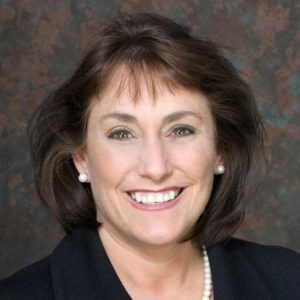
The rationale for launching San Diego Women’s Week was not immediately apparent to the three men on the North San Diego Business Chamber’s executive committee when CEO Debra Rosen laid out the plan on the Wednesday before Thanksgiving in 2009.
They wondered — what does this have to do with business and why would the chamber host a series of events for just women?
Rosen’s response was this: “Female leadership is less than it should be and we need to do more to promote this within business.”
After much dialogue, Rosen was given approval to move forward on San Diego Women’s Week, under certain conditions:
- 50 percent of projected revenue must be raised by Jan. 2 — five weeks after the original meeting.
- Rosen persevered and raised 199 percent of projected expenses within three weeks.
“Nine years ago, working with the partners meant connecting with the marketing groups of companies and getting their support,” says Rosen today. “Over the course of those nine years, the decisions went from marketing departments to human resource departments and now we work primarily with Diversity and inclusion or Women’s groups.”
The result: Nine straight years of growth for the event with respect to attendees and partnership revenue.
Events during the week have been scheduled at different places around the county so that member companies could be part of the experience and showcase their properties. And because of the continued growth, the Leadership Conference was moved to the Town and Country Hotel this year. which will allow for growth over the next couple of years.
“The focus has always been on Empowerment, Inspiration and Leadership,” says Rosen.
Conference speakers from past years have included: Mariel Hemingway, (appearing again this year); Padma Lakshmi, Elizabeth Smart, Deepak Chopra, Gayle Wilson, Amy Cuddy, Naomi Tutu (appearing again this year), Susan Packard, Tanya Brown, Scout Basset and Piper Kerman.
______________________

Mariel Hemingway
“Everyone has a voice”
By Teresa Warren
Mariel Hemingway is an Academy Award-nominated actor, prolific author, adventurist, eco activist, healthy lifestyle and mental health advocate, yoga video star, entrepreneur and much sought-after speaker focused on mind-body-spirit optimization and purposeful living. She took time out of her hectic schedule to answer a few questions in anticipation of Women’s Week.
- You’ve spoken at Women’s Week before. What is it about the event that keeps you coming back?
Mariel: The mentality of Women’s Week – the focus on “how do I get better?” and stepping into our own power — everyone has a voice — and sharing that voice and how we create own own voice of wellness, balance with others and the feeling of being connected.
- Are your messages different when you are talking to women vs. both men and women?
Mariel: I do adjust my messaging. When I look into a sea of female faces, it’s easier to relate, but in general I believe that connection, balance, health and wellness crosses all boundaries. We are all human beings — we still eat food and want to connect with others. We are all on such similar journeys, so gender doesn’t really matter. But when I do talk to women, I see our struggle to be perfect — I feel that when I look into a crowd.
- As individuals, how are we most likely to let ourselves down, and how can we start to build ourselves up?
Mariel: So many of us are hyper-critical of ourselves. That comes from a message in the back of our brain that we aren’t good enough. We think about the things we haven’t done and how we aren’t where we we thought we would do by this time. Instead of waking up being critical of yourself, show gratitude first…take some moments to really appreciate where you have come from and show gratitude, then make new choices to become better. Show yourself gratitude every single day.
- You are quoted as saying “We all have stories and we must tell them to let them go.” How do we let go?
Mariel: To move on from where we come from, from our stories — the nonsense that we created or was created for us by those that came before us … find someone that you feel safe with and good about and tell your story. You may have to speak about it or write about it. That’s the beginning of the healing. You may need to tell it many times … it becomes a story and not who you are. Letting it go is transformative.
- You travel extensively and speak to many people, what is the common theme you hear from women?
Mariel: I tell my story so much … of family, addiction, suicide, then joy … many people say they have the same story. When they tell me their story, it isn’t the same, but emotionally it is. It is very healing. And I love. I am doing what I am so supposed to be doing because people need to be heard.
______________________
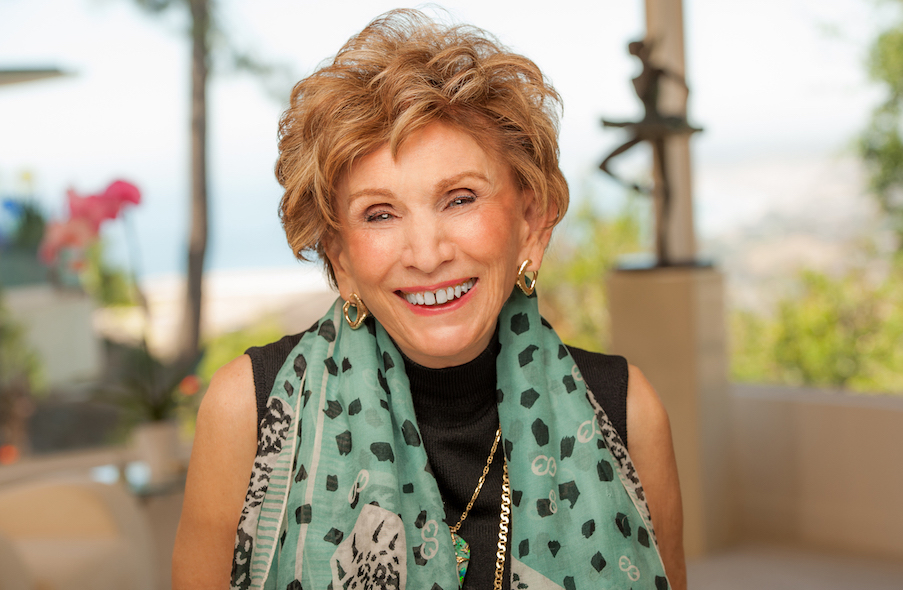
Edith Eger
Choosing strength through one’s own thoughts
By Jennifer Coburn
When 16-year-old Edith Eger arrived at Auschwitz concentration camp in 1944, her parents were ordered to join a group on the right, and she and her sister were told to step to the left.
Later that day, as her mother was murdered in a Nazi gas chamber, young Edith was forced to dance for the infamous Dr. Josef Mengele. But despite the horrors she lived through, she always held tight to what her mother told her in the cattle car to the concentration camp. She told her daughters she didn’t know what would happen to them, but that no one could take away what was in their minds. Regardless of what was happening in the world, they could always choose their reaction to it.
On that fateful day at Auschwitz, the Hungarian teen made a choice. As she danced for one of the most notorious war criminals, she put into practice her mother’s sage advice. Edie closed her eyes and imagined she was dancing the Romeo and Juliet ballet to the music of Tchaikovsky at the Budapest Opera House.
In many ways, this decision saved her life. Dr. Mengele offered her a piece of bread as reward for her performance, which she gladly shared with the other women in her barracks. Months later, while Edie was on a death march, she felt so weak she could not go on. But the women with whom she shared her bread day that first day at the camp joined together and carried her. She uses that as an example of how our choices help shape our lives wherever we are. She also recalls the day she and her sister’s heads were shaved at Auschwitz. “She asked me, ‘How do I look?’ and I told her, ‘You know, you have beautiful eyes and I never really noticed them before with all of your hair.”
“You decide what to focus on. You always have that choice.”
Today, the 90-year-old psychologist still deeply believes in her mother’s parting words to her. She works with victims of abuse and veterans suffering from post-traumatic stress disorder, focusing on what she calls the “hope in hopelessness.” She says her work is to help people “free themselves of the concentration camp of our own minds.”
Her memoir “The Choice” was released last year to critical acclaim and sold-out audiences at book events. She will address San Diego Women’s Week conference attendees with her message of choosing strength through one’s own thoughts. “I want us to recognize that we have the strength within ourselves and that we are connected in mind, body and spirit,” she says. “All of the power comes from within and we must stop wasting time waiting for someone to complete us.”
Eger defines strength as financial and emotional independence, but also compassionate listening and childlike curiosity. “I am the most curious 90-year-old, I love to learn,” says the doctor who is known to end her talks by lifting her leg in the air with the full extension of a professional ballerina. “I’m still here and that is the best revenge.”
______________________
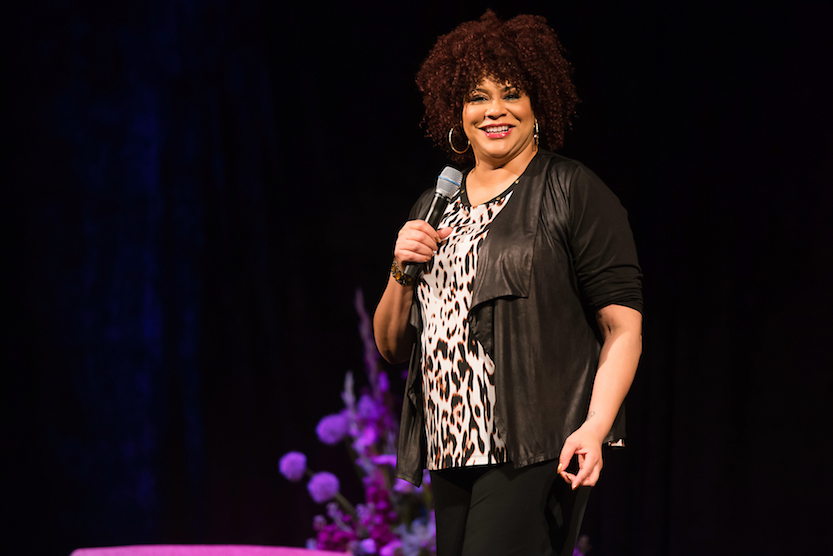
Kim Coles
Discover your own true “gifts” and share them with others
By Randi Crawford
Kim Coles is a comedian, author, actress, speaker, and terrific teacher. Kim will make you laugh. You may know her from her hugely popular series, “Living Single,” or seen her on a multitude of hit shows including “Frasier,” “Six Feet Under,” “In Living Color,” as well as several guest spots on daytime talk shows.
But today, we’re talking about loving your story.
Cole’s newest venture is combining her comedic talent and inspiration to empower others with a unique program called Open the G.I.F.T.S. The program inspires others to discover their own true “gifts,” so that they may share them with the world.
Why would Coles undertake the program, since she already is an accomplished actor and comedian? She explains that every comedian/actor’s journey is different. Her journey started when she was in and out of college. During a hiatus, she entered a beauty pageant for plus-size women. Thirty days prior to the pageant, she received a call stating that a talent competition was being added. Coles panicked because at the time, she didn’t know her talent. She considered taking tap lessons but quickly realized that she wasn’t going to be a beast tap dancer in 30 days. Recalling her high school days of being funny, she decided to make a comedy routine based on beauty pageants. And then during her routine, she ripped off clothing to reveal a sequined leotard and started twirling a baton to the tune of Michael Jackson’s “Thriller.” She was a hit. On that stage, Coles said she felt the wave of love from her audience. That is when she decided she needed to be a comedian.
Her career took off fairly quickly after that pageant. She started performing at comedy clubs and appeared on local television. She booked the pilot for “In Living Color.” Basically, from 1985-1998, Coles could do no wrong. Everything she touched turned to gold.
Coles says her involvement in “Living Single,” which was on the airwaves for five years, was “the sparkling jewel of my career.” But when it went off the air, she was left with no other means to support herself. When the money stopped coming in, Coles went on a shopping splurge. She basically shopped all her money away. “Some people drink, some take drugs, some gamble, but for me, it was shopping,” she says. And she didn’t discriminate. She would shop at Neiman Marcus or the 99 Cent store — as long as she was shopping, she was living. Kim started to dig deep and ask herself the questions, “Am I still relevant? Do I still have talent? Do I still belong?
It was a quote from motivational speaker Zig Ziglar that roused Coles out of a depression: “You can have everything in life you want, if you will just help other people get what they want.”
Coles believed she had gifts inside of her, and would share her gifts with other people.
Coles added motivational speaker to her resume and has been taking that same guiding spirit and empowering people, combining comedy and inspiration in her transformational program called G.I.F.T.S, designed to inspire you to discover your own true “gifts” so you may share them with the world. G.I.F.T.S stands for gratitude, intention, forgiveness, triumph and self- love.
“Nothing works better than sharing who you are,” says Coles. “It engenders others to want to work with you. It’s incredibly powerful.”
She offers a seven-day challenge called, “Choosing You.” YOU stands for Yielding to your purpose, Overcoming obstacles, and Upgrading your life.
Visit www.kimcoles.tv to access Kim Coles and her story.
______________________

Janice Freeman
The voice of positivity
By Cecilia Buckner
How do you move on from a diagnosis of cervical cancer and lupus?
For West Covina resident Janice Freeman — you become a finalist on “The Voice.”
And her positivity and faith are what got her there. “If we understand the power that we truly have, that God gave us … the power of prospective … the power of what you allow your thoughts to ponder on … that changes your whole reality,” Freeman said.
It has not always been an easy process though. “I was very pessimistic and angry,” said Freeman, who at 7, fought for her life with kidney failure and at 14, was diagnosed with meningitis.
One of seven children raised in a single-family home in Harrisburg, Pa., Freeman had serious health issues, and she had a hard time dealing with the loss of family. Her grandfather and uncle were killed in a car crash before she was born. When she was a pre-teen, her brother was shot to death.
“What I couldn’t get over or fathom in my mind,” Freeman said, “he left that day. Any other normal day, he would come walking back through the door, and he didn’t. “
During that same period of time, Freeman’s grandmother died of breast cancer and her aunt of AIDS. “To see my aunt die … her life every day just disintegrating … that was just hard,” she said.
Freeman turned to the church and music for solace. As a teen, she began singing with a praise dance ministry at a church in Pasadena, which branched out into girl gospel group, M.I.G. (“Matured in Glory”). The group once traveled to Japan to sing their praise-filled music, including their first single, “It’s Not About Us.”
Eventually going the solo route, Freeman auditioned for “The Voice,” not making it through the first round. After several attempts, she not only made it on the show, but achieved a top-11 spot in Season 13. It changed her life tremendously, Freeman said. “Everything is falling into place.”
She had been praying for a platform to affect lives with her music and “The Voice” gave her that. “You know, we grow up … especially being an African American … things happen and they tell you to sweep it up under the rug or tell God about it and be quiet. And we never get to really talk about it, which brings about healing,” she said. “Look where I was and now look where I’m at and you can do it too. I am going to talk about it. That’s an aspect of my life I know God is calling me to do.”
Freeman, 32, has been married to husband, Dion Neuble, a drum player, for more than two years and has one daughter, Hannah, 11.
Although cancer-free following a hysterectomy, Freeman still struggles through tiredness and illness associated with lupus, but remains positive. “You can change your situation. That can change the world. You have the power,” she said.
Freeman dubs her genre “Alternative Soul.” Some of her music can be found on iTunes, as well as SoundCloud. Also, follow Freeman on Facebook at janicefreemanlive; Instragram at Janicefreeman; and Twitter at janice_freeman.
______________________
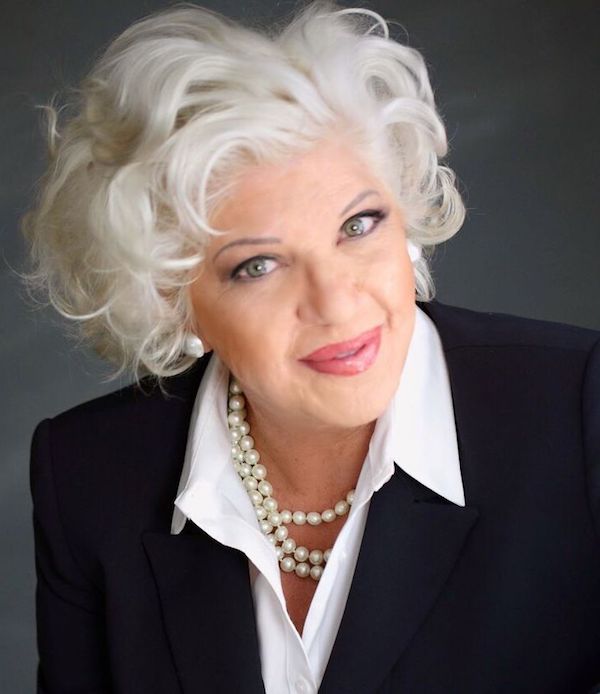
Lesia Cartelli
A crusader for the power of resilience
By Jennifer Coburn
When Lesia Cartelli speaks to San Diego Women’s Week attendees about the power of resilience, she will be sharing lessons learned the hard way. She was severely burned in a natural gas explosion that blasted nine family members across the street and destroyed Lesia’s grandparents’ Detroit home. The young girl was playing in the basement at the time and was buried in the rubble. She managed to crawl out on her own, then rolled in the snow and dirt to extinguish the blaze that was her body.
Lesia’s childhood experience was the first time she realized the power of resilience, but it wasn’t the last. She went on to become the founder and chief executive officer of Angel Faces, a nonprofit organization that provides healing retreats and ongoing support to adolescent and young women with severe burn and trauma injuries. She is a sought-after speaker and author of “Heart of Fire,” her story of overcoming adversity. “I didn’t want all of that pain to be wasted by not doing something with it,” says Cartelli. Her message is one of “finding the gift in hard times,” she says. “Not everyone has a tragedy, but pain can be a great motivator and out of these experiences we can find healing.”
Cartelli says the key to building resilience is changing one’s perception of hard times. “You have to dig for the gift in the pain,” she says. “You may not get it right away, but it will come because it is there.” Cartelli says she will discuss the markers of resilience and share stories from others who have surmounted daunting obstacles.
Many of Cartelli’s stories of inspiration are born from the Angel Faces retreats, which are limited to 20 participants because of the intensity of the weeklong program in New Hampshire. The curriculum focuses on self-love while accepting and embracing trauma and disfigurement. Group sessions led by licensed psychologists focus on emotional healing through discussion, journaling, and art therapy. “There are so many magical moments,” Cartelli says of the retreats. “The beauty is that there are no boundaries by race or socio-economic status, the common chord is pain and resilience.”
Cartelli recalls a recent retreat where two girls from very different backgrounds made a very special connection. One girl had lost her hair in an accident, while the other had long, lush locks. Although the second girl had also suffered trauma and a disfiguring injury, she offered to cut her hair to make a wig for her new friend. “We need to look beyond the hair and see another woman as a sister, a friend, and see that people love her and care for her and we should too,” says Cartelli.
Changing our perception of life experiences, hard times in particular, isn’t always easy, but it’s always worth it, says Cartelli. “Every morning I wake up and instead of thinking about what I have to do, I realize it is what I get to do,” she says. “It’s not a duty, it’s an opportunity.”
Cartelli recalls a day when her work felt overwhelming until a girl who was severely disfigured approached her and wrapped her arms around her at a retreat. “She asked me if I had any idea how I was saving her life and I realized I was exactly where I was supposed to be.”
______________________

Corrie Mays
Q & A with a former Blue Angel
Last year, Marine Corps Capt. Corrie Mays finished her assignment as Blue Angel #8, making her only the second woman to be selected for one of the Blue Angels’ numbered positions (one through eight).
Q: Can you describe what your duties were with the Blue Angels?
Corrie: I handled all the event planning and served as the squadron Naval flight representative. We fly F-18s in the fleet. I represented the two-seat community, meaning weapons systems officers who fly in the back seat. As the Blue Angels event planner, I took care of all future operations for the Blue Angels. During the show season, I coordinated air space, air show layout, hotels, gyms, police escorts and public relations.
Q: We’ve seen a groundswell for women’s equality this past year. As one of the first female Blue Angels, what has this movement meant to you?
Corrie: I hope that for any women out there, no matter their age, if they have felt held back, this helps them realize that they shouldn’t let anyone else create barriers or shouldn’t create barriers of their own. Anything is open to anyone. Go for it.
Q: What inspired you to join the Marines?
Corrie: 9/11 planted the seed. I wanted to be part of the solution and help in any way I could. After I graduated college, I worked a civilian job for a few years first, but it wasn’t fulfilling. I would watch jets flying overhead at a nearby military base, and I couldn’t stop looking at them. They weren’t doing anything fancy, but they were still awe-inspiring. I wanted to realize my potential more and give back. I’m the kind of person where, if I’m going to do it, I’m going to go all out. The operational and tempo structure of Marines appealed to me.
Q: Why do you think we don’t have more female aviators?
Corrie: I don’t know the answer. The field is open to anyone. You find a lot in the Air Force and Navy. Due to the nature of the Marine Corps, it has the smallest percentage of women, and its female aviation community is even smaller. The female fighter community is even smaller than that. The numbers are increasing, though.
Q: What would you say to young women who have aspirations to do what you’ve done?
Corrie: I encourage everyone, no matter where they are in their journey or what they’re doing, to always give it their all. If they perform their best, they can truly ask themselves, “is this something that makes me happy?” Performing at your peak opens doors.
Q: What qualities do you have that propelled you to achieve in your career?
Corrie: I credit my father for showing me the impact and effectiveness of an awesome work ethic. He was an aviator who flew commercially his entire life. I’ve always done the job as best I can until the end.
Q: What’s one highlight of your career?
Corrie: The people I’ve worked with. Being able to learn something from as many people as I can has contributed to where I am.
Q: If you couldn’t be a pilot, what would you do for a living?
Corrie: I own a business with my sister now — a Cape Cod gift shop called Plum Porch, and I’m transferring to the Marine Reserve in a few months. Work-life balance is important but also one of the most challenging things. I think the transition from active duty to reserves will help me reconnect with family.
______________________
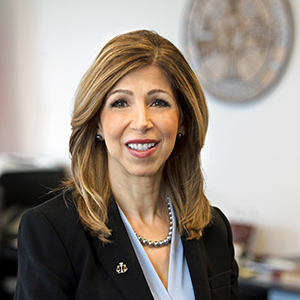
District Attorney Summer Stephan
District Attorney Summer Stephan has devoted her life to protecting children and families and providing justice to the voiceless and most vulnerable. She is a national leader in the fight against sexual exploitation and human trafficking, who has served as a Deputy District Attorney in San Diego County for 27 years. During this time, she combined extensive courtroom experience with over 15 years of management and leadership experience. She rose through the ranks to appointments as Chief of the DA’s North County Branch and Chief of the Sex Crimes and Human Trafficking Division, a Special Victims Unit she pioneered. In 2012, she was appointed Chief Deputy District Attorney. In 2017, she was appointed District Attorney.
Stephan leads the second largest DA’s Office in California, managing a professional staff of over 1,000 employees, serving as the People’s Prosecutor for all of San Diego County and its over three million residents, which are spread throughout cities and communities from the U.S.-Mexico border to the Riverside County line. The DA uses her nearly three decades of experience to set public safety priorities and to leverage, partner, and collaborate with law enforcement and the community to maintain San Diego County as one of the safest urban regions in the United States.
As a trial prosecutor, Summer tried more than 100 jury trials, including cases of complex homicides, sexually violent predators, child molestation, sexual assault, school shooting, and human trafficking-related cases.
She holds leadership positions in public safety on the national state and local level, including being selected as one of only two prosecutors in California to serve on Governor Schwarzenegger’s Task Force for High-Risk Sex Offenders and Sexually-Violent Predators. Among her many leadership positions in the fight against human trafficking, Summer chaired the San Diego County Human Trafficking Advisory Council. She spearheaded the innovative “Know the Price” campaign, which focused on reducing sexual assaults of college students. She also led the award-winning “The Ugly Truth” Human Trafficking Campaign.
She is a leader in advancing public safety through a smart, fair and equal criminal justice. She brings solutions to complex issues through her unique data-driven and common sense approach that goes beyond a one-size-fits-all mentality. Instead, she leverages innovations in crime prevention and restorative justice practices and believes in investing in and building healthy lives and communities instead of destructive and costly prison pipelines. For example, Summer was part of the leadership team that diverted more youthful offenders into positive programs
while lowering recidivism and harm to communities, dramatically lowering the incarceration rate for juvenile offenders by 48 percent. In addition, she helped implement and expand smart on crime programs that address the underlying causes of criminality for non-violent offenders such as mental health, substance abuse and addiction. In addition, she began the first Veterans Treatment Court in North County with Deputy DA George Loyd, a heroic Marine Corps veteran.
Summer is the recipient of numerous local, state and federal awards, including an FBI commendation for organized crime prosecution, the outstanding achievement award for the complex prosecution involving the sexual assault and murder of an elderly woman. She was named “Angel of Anti-Human Trafficking” and “Modern Day Abolitionist. She received the prestigious 2016 “Voices for Justice” award by the Interfaith Center for Worker Justice. This year, she received the Lifetime Legacy Award by Women of Influence and the Community Impact award by North County Lifeline.

